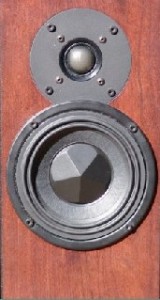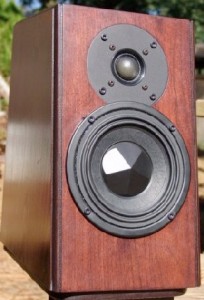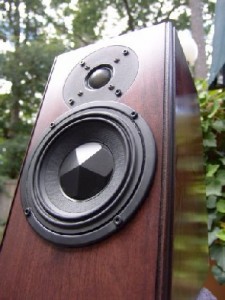“Tell it like it is” transducers are nothing new. Recent trends in loudspeaker design suggest that there is a widespread embrace of this design philosophy that has many listeners ditching their less than ruler flat speakers in favor for something with a more even and linear frequency response. Still, there are those that feel the path towards musical truth does not rest within transparency and neutrality. As speakers with stand out character begin to take a back seat along the hi-fi boulevard, you can always count on someone to buck the trend.
Specifications:
- 89 db efficiency
- 8 ohm nominal impedance
- 48hz – 29khz +/- 3db
- RMS power handeling; 12w – 150w
- 10″D x 13″ H x 7″ W
- 36 lbs a pair
- Real Wood Veneer ( 10 options )
- Time Aligned, Rear Ported Design Retail: $795/pair ($100 extra for a lacquered finish)
- Component Retail: $795.00 / pair
Enter Odyssey Audio
At the beginning of the new millennium, a wave of ambitious consumer-direct entrepreneurs hit the market with a suitcase full of ideas to do just that. Unfortunately, high end audio is a small pond – one which is difficult to survive in. While many companies have already faded into obscurity, others, like Klaus Bunge’s Odyssey Audio, continues to flourish and make headlines. Then again, most companies did not start off by offering a product that challenged existing standards and preconceived notions.
For Odyssey Audio, that component is the Stratos, a heavy solid-state amplifier whose lineage stems directly from the well respected and upscale Symphonic Line out of Germany. The release of the Stratos announced to the market that you no longer had to be part a high income tax bracket to play with high quality, high powered solid state toys. The endearing virtues that made the Stratos so desirable; great build quality, sound, warranty, and competitive value – are put into every product that bears the Odyssey Audio logo.
Although famous for his electronics, Klaus has also become well known for offering high quality loudspeakers; most notably the Epiphany monitors and Lorelei floor standing towers. The Epiphany, a compact two-way monitor, was created to not only complement the existing array of Odyssey Audio electronics, but to also deliver solid performance and great value regardless of the associated gear. It was a speaker aimed towards the budget conscious audiophile that desired a well built and affordable musical performer. When the Epiphany was released into the market, it received instant praise for its warm character, huge soundstage and easy going presentation. For years, it has been a staple within the Odyssey Audio product line up.
Yet like most things in business, the time eventually arrives when a product must be improved upon to remain competitive. Klaus knew that he had to pull all the stops to offer an even higher performance loudspeaker at a similar price point. The design goals were very specific; to remain true to the original design capturing existing strengths and taking them to a whole new level.
Odyssey Audio Epiphany 2 review
Introducing the Epiphany II
Usually one can expect only incremental gains from a product that enters version 2.0. This is because most of the time, the purpose of such an upgrade is to simply address only the most notable shortcomings. It is a safe to consider such changes to be more of a facelift, than a full blown upgrade. For every standard however, there are exceptions. The Epiphany-2 is one of them. Aside from the familiar sloped time aligned baffle, the new Epiphany shares very little in common with its predecessor.
The most striking improvement over the original Epiphany is the new look. No longer confined to a plain looking box, the new Epiphany enjoys the classy Lorelei treatment. Real wood veneer now wraps entirely around the cab, complemented by accenting side grooves. Although there is no bracing used with the Epiphany II, the entire speaker is built using three quarters of solid MDF, making for a very rigid and non resonant cabinet. You will find no “Made in China” customs labels stuck on the back of any Odyssey speakers. That is because each set is built by a custom furniture designer in Indianapolis, Indiana. Impressive as the looks may be, the bulk of the improvements are under the hood where we see an immense increase in parts quality.
The Epiphany2 now uses an Usher tweeter that is an exact replica of the highly praised and expensive, Scan Speak 9500 soft dome. Complimenting the tweeter is the unique Tang Band W5 876SD high excursion paper woofer. The entire first order crossover network is full of premium parts, including Sonicaps and Alpha Core air coils, which are used to keep the woofers under control. Between major upgrades in cosmetics, build quality, and parts quality, the Epiphany II saw a whopping 105% parts cost increase over the original model, which explains the slight increase in price.
Set Up
I’ve never been the kind of person to shy away from extremes. I am the type of guy that would give anything to strap into the cockpit of an F/A-22 Raptor, yet at the same time refuse to step anywhere near a theme park roller coaster. Not so surprisingly, this character seeps its way into home audio. During my evaluation of the Epiphany II, I decided to use two components with opposite pedigrees; the very pedestrian Harman Kardon 3470 stereo receiver, and a pair of high performance separates with a combined price tag of $7,000, courtesy of H2O Audio. Surprisingly enough, while the Epiphany 2 showed obvious gains when paired with the more expensive gear, the improvements were not as dramatic as one would suspect given the extreme jump in quality. This suggests nothing against the H2O separates. Instead, all it means is that the Epiphany 2 holds true to its stripes. It is what it is, and nothings going to change that.
Setting up the Epiphany II requires the same amount of care you would give any other ordinary set of rear ported speakers. Unless you fancy boom box hi-fi, you will need to keep the speakers at least a foot and a half away from any surface wall or boundary. Otherwise, the Epiphany II is very easy to work with and is fairly liberal in regards to room placement. As per usual, I preferred the sound with slight toe in, with the tweeters facing just outside of my listening position. I always end up coming back to this placement in rooms both big and small, simply because it helps give the presentation focus.
The Sound of Epiphany 2 – The Short, Short Version
Upon strumming the first musical notes, it became clear that the Epiphany 2 tells the story of song from a laid back perspective. The sound is warm, textured, and inviting. This is not the kind of transducer that will impress you with whiz-bang detail and speed. Unashamed of its colorful presentation, the Epiphany II uses its assets to create a wonderful sense of musical flow. Warm mid-range bloom, prestigious bass, and high-end sparkle are always present, giving off a consistent performance that never fails to keep your head bobbin’ and your foot tappin’.
The Sound – The Long Version
Let me make this perfectly clear; the Epiphany II sways far from the “tell it like it is” variety of loudspeakers. This is a monitor with distinct character. The overall tone is laidback, if not a bit dark. Many audiophiles would refer to this sound as more of a “back hall perspective”, which is akin to sitting a good number of rows back from the performer’s stage. You are still getting all the life and zest from the music, it’s just not slapping you in the face to command your attention. This is a presentation for those that like a more reserve approach.
While the Epiphany II is undoubtedly reserve in nature, I was surprised with just how much high end energy and sparkle was present. It is not uncommon for speakers that boast of a more tame presentation to give up a bit of fine detail and lowlevel resolution. While the Epiphany II is not the last word in either category, as no sub 1k monitor is, I found that its treble strayed far from the stereotypical “silky smooth” reference that is often associated with laid-back speakers. Although the Epiphany II tends to sound its best when you feed it a healthy dose of current, it nonetheless has enough presence in the top end to deliver a satisfying presentation even at soft volumes. Never once did I feel like I was missing any critical detail embedded within the music. All that I needed was there to be heard and enjoyed. The Epiphany II has a number of virtues, the most stand-out of which is its ability to create an extremely wide and palpable soundstage that manages to fill rooms both big and small with well separated, room filling sound. When it comes to ultra budget hi-fi, you are hard pressed to find a speaker that can deliver a soundstage that can not only separate instruments and vocals well, but also give them their own distinct space. The Epiphany II now joins the very impressive Ascend Acoustics Sierra 1 in this regard. That’s good company to be in.
Another great virtue of the Epiphany II is its midrange. Thick, rich, blossomed, warm, are just a few of many audiophile adjectives that can be used to describe the sound. As I listened from disc to disc, ranging anywhere from old rock, to jazz, to electronic, I could not help but think of the beguiling Spendor Classic SP 3/1P monitors. This is not to say the Epiphany II is perfectly identical in that regard, it just means that the blossomed midrange had the same effect on the music the Spendors had. There is a sense of palpability and presence that is positively addicting. From Jimmy Hendrix to Dave Brubeck – the rich midrange added life to the music, even on recordings that are less than ideal. You won’t need tubes to bring out this bloom, solid state will do just fine. Anchoring the mid-range may is perhaps the most attention grabbing element of the Epiphany II; extremely powerful bass that is tout and full. Much like the midrange, there is some extra emphasis in the bass that successfully creates the illusion of a bigger speaker at play. This is no new trick as there are many similar sized monitors in the market that attempt to do the same thing. The only difference is, the Epiphany II can actually pull it off. While most of these monitors stop producing convincing levels of bass around the 60-70hz point, the Epiphany 2’s easily hit 50hz. This is the type of speaker that will have your audiophile buddies searching the room for that hidden subwoofer. It’s surprising how hard this small speaker hits, and how low it can go.
While it may be a stretch to call the bass linear and quick, it is by no means slow or sluggish. The Epiphany II is still able to handle complex bass passages with a weighty character that is particularly pleasant with the acoustic guitar and cello. Make no mistake however, great power handling allows her to deliver quite a punch with all forms of music, and yes, even with hip hop. At the end of the day, the Epiphany II is one of the few affordable compact monitors I’ve stumbled across that can move enough air to leave me perfectly content with its performance au natural’. As usual, those who thirst for the lowest of octaves are encouraged to use a high quality sub to quench those bass needs.
The Drawbacks
Compromise; it’s the yin and yang of our hobby. In order to gain an asset, you must be willing to give up something else in return. Like any audio component, the Epiphany II is not without its own assortment of shortcomings. Bearing to mind that this speaker was never designed to do all the ‘audiophile things’ to perfection, I feel that some of the compromises are obvious and do not require formal mention. I will instead focus on the notable drawbacks as they pertain to the products design.
As mentioned above, the Epiphany II sports a surprising amount of high end energy. During my evaluation, I often felt that it could have benefited from a bit of attenuation, especially during female vocal passages with those dreaded S and TH pronunciations. I also felt that the Usher driver used on the Epiphany II sounded a bit rough compared to the Sea’s driver found on the Ascend Acoustics Sierra 1. While the high end is not un-refined per say, it would not consider it ultra smooth either.
Strong, clean bass is the one thing most people look for when they shop for compact monitors. While the Epiphany II delivers the goods that lends itself to a wide variety of music, I feel that in some circumstances, all that bass can end up being too much of a good thing – especially on recordings that already possess strong levels of bass. I found this to be particularly noticeable with modern rock music from bands like; Incubus, Porcupine Tree, The Smashing Pumpkins, Seether, The Red Hot Chili Peppers, etc, groups that require no assistance in that department.
And finally, to those of you about to rock; just bear in mind that the Epiphany II is a compact two-way loudspeaker, and there is only so much clean output she can deliver until losing her composure / articulation. When it comes time to pump up the volume, you will find that the Epiphany II is the type of gal that wants to be fed generous helpings of clean current. While she can easily perform on a low calorie diet, it takes a lot of juice to really make her groove.
Conclusion
While there is no shortage of good speakers in the sub 1k market, there is little out there like the Epiphany II. Few in its price class can match its over-all versatility and dynamic range, and even fewer can communicate the music in such a delightful and enjoyable way. The best part is, you don’t need to own the best electronics, or run the best recordings to get good sound from this loudspeaker. Able to adapt to most real world listening situations – the Epiphany II gives you consistent performance that is always full and engaging.
Throughout the reviewing process, every listening session turned longer than expected, often extending into the early A.M. No matter what music I threw their way, the Epiphany II always kept my foot tapping along to the tunes. Bearing to mind all that you get for your hard earned coin, I feel that the Epiphany 2 delivers the goods where it counts the most. Highly recommended!
Review System
- Source: Arcam Diva 62 ; E-MU 1212M Pre Amplifier: H2O Fire
- Power Amplifier: H2O Signature 150, Harman Kardon 3470
- Cables: Totem Acoustic Sinew interconnect ; Totem Acoustic “Tres” speaker cable; Zu Cable “birth” power cable
- Room Treatments: GIK Acoustics 242 Panels
 from affordableaudio, By Zero
from affordableaudio, By Zero




